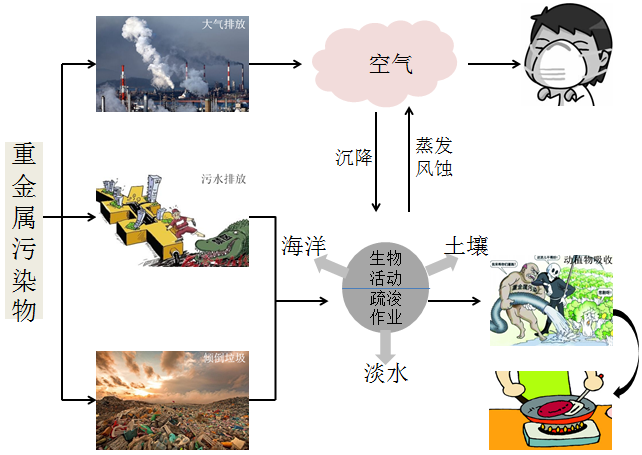磁性Fe3O4@SiO2-CS的制备及其对Cr(VI)的吸附性能毕业论文
2021-02-28 09:02
摘 要
重金属废水的治理是当今社会发展过程中亟待解决的问题,本文致力于研究制备方法简单、吸附后易于分离的磁性壳聚糖吸附剂。首先,通过水热法制备Fe3O4纳米粒子;然后,采用正硅酸乙酯水解的方法在Fe3O4纳米粒子的表面包覆SiO2,制得复合磁性载体Fe3O4@SiO2;最后,采用壳聚糖交联的方法包覆磁性Fe3O4@SiO2,制得磁性Fe3O4@SiO2-CS复合材料。运用XRD、FT-IR、SEM、N2吸附-脱附和VSM等表征测试手段对磁性Fe3O4@SiO2-CS的物相结构、形貌特征、织构性质以及磁性能等进行分析,并评价了典型样品对模拟Cr(VI)废水的静态吸附性能,所得结果如下:
(1)球形纳米粒子Fe3O4粒径分布在200-400 nm之间,经SiO2包覆之后比表面积由23.8 m2/g 增至115.3 m2/g,Fe3O4@SiO2的饱和磁化强度为52.7 emu/g。
(2)CS通过戊二醛的交联成功包覆在磁性载体Fe3O4@SiO2表面,制得了磁性Fe3O4@SiO2-CS复合材料,其饱和磁化强度降至3.2 emu/g,但仍可通过外加磁场实现磁性分离。样品Fe3O4@SiO2-CS的比表面积仅有3.0 m2/g,平均孔径为16.06 nm,这可能因大量磁性载体被包覆在壳聚糖交联网络结构中形成整块的磁性壳聚糖树脂所致。
(3)经制备条件的优化,典型Fe3O4@SiO2-CS样品对100 mg/L 模拟Cr(VI)废水的吸附量高达96 mg/g,吸附性能满足拟二级吸附动力学模型;循环再生实验表明,NaOH溶液可以作为该样品饱和吸附Cr(VI)后的脱附再生剂,且5次循环实验后样品对Cr(VI)的吸附性能仍保持原有吸附量的82%。
关键词:Cr(VI)废水,磁性,壳聚糖,Fe3O4@SiO2-CS,吸附剂
Abstract
The treatment of heavy metal wastewater has become an urgent problem to be solved in the development of industry. In this paper, firstly, Fe3O4 nanoparticles were prepared by hydrothermal method; then, SiO2 was coated on the surface of Fe3O4 nanoparticles by hydrolysis of ethyl orthosilicate; finally, magnetic Fe3O4@SiO2 was coated by chitosan crosslinking method to prepare magnetic Fe3O4@SiO2-CS composites. The structure, morphology, texture and magnetic properties of magnetic chitosan adsorbents were characterized by XRD, FT-IR, SEM, N2 adsorption-desorption and VSM. And the static adsorption performance of typical samples for simulated Cr(VI) wastewater was evaluated. The results are as follows:
- Fe3O4 nanoparticles have a particle size distribution between 200-400 nm, and the specific surface area is increased from 23.8 m2/g to 115.3 m2/g after SiO2 coating. The saturation magnetization of Fe3O4@SiO2 is 52.7 emu/g .
- CS was successfully coated on the surface of magnetic carrier Fe3O4@SiO2 by glutaraldehyde crosslinking. The magnetic Fe3O4@SiO2-CS composites were prepared and the saturation magnetization was reduced to 3.2 m2/g, but it can still be separated by an external magnetic field. The specific surface area of Fe3O4@SiO2-CS is only 3.0 m2/g and the average pore size is 16.06 nm, this is probably because a large amount of magnetic carrier is coated with chitosan and form a monolithic magnetic chitosan resin.
- The adsorption capacity of typical Fe3O4@SiO2-CS samples to 100 mg/L simulated Cr(VI) wastewater was 96 mg/g, and the adsorption process of Cr(VI) fits well with the pseudo-second-order adsorption kinetics model. The recycle experiments showed that the NaOH solution could be used as Cr(VI) desorption regeneration agent. And the adsorption capacity of Cr(VI) remained 82% of the original adsorption capacity after 5 cycles.
Key words: Cr(VI) wastewater, magnetic, chitosan, Fe3O4@SiO2-CS, adsorbent
目录
摘要 I
Abstract II
目录 III
第1章 绪论 5
1.1研究背景 5
1.2常见Cr(VI)废水的处理方法 6
1.2.1沉淀法 6
1.2.2氧化还原法 6
1.2.3电化学法 7
1.2.4吸附法 7
1.3壳聚糖及其衍生物的吸附 8
1.3.1壳聚糖/珍珠岩复合吸附剂 9
1.3.2壳聚糖/蒙脱土改性吸附剂 9
1.3.3壳聚糖/聚乙烯醇复合吸附剂 9
1.3.4壳聚糖/磁性复合吸附剂 10
1.4 本文的选题意义及研究内容 11
第2章 Fe3O4@SiO2-CS复合吸附剂的制备与表征 12
2.1 引言 12
2.2 Fe3O4@SiO2-CS复合吸附剂的制备 12
2.2.1实验试剂和仪器 12
2.2.2样品的制备工艺 13
2.3表征测试 15
2.3.1 XRD 15
2.3.2 FT-IR 15
2.3.3 SEM 15
2.3.4 N2吸附-脱附 15
2.3.5 VSM 16
2.4表征结果与分析 16
2.4.1 XRD分析 16
2.4.2 FT-IR分析 17
2.4.3 SEM分析 18
2.4.4 N2吸附-脱附分析 19
2.4.5 VSM分析 21
2.5 本章小结 21
第3章 Fe3O4@SiO2-CS对Cr(VI)的吸附性能 23
3.1引言 23
3.2吸附实验部分 23
3.2.1实验试剂和仪器 23
3.2.2 Cr(VI)的吸附性能测试 24
3.3结果与讨论 25
3.3.1壳聚糖浓度对吸附的影响 25
3.3.2戊二醛浓度对吸附的影响 26
3.3.3吸附动力学 27
3.3.4再生性能 29
3.4吸附机理分析 30
3.5本章小结 30
第4章 总结与展望 32
4.1总结 32
4.2展望 32
参考文献 33
致谢 38
第1章 绪论
1.1研究背景
随着我国工业的不断进步发展,工业废水排放问题受到了越来越多的关注,重金属铬主要来源于采矿、电镀、颜料、皮革蹂制中的工业废水和垃圾渗滤液,含Cr(Ⅲ)和Cr(VI)的工业废水易引起地表水和地下水的铬污染,对生态环境造成严重威胁[1,2]。铬可以通过消化道、呼吸道和皮肤侵入人体,主要聚集在肝肾和内分泌腺中,易引起慢性中毒,导致局部器官损坏甚至进一步恶化,如图1-1所示。相比Cr(Ⅲ),Cr(VI)具有更强的氧化性、腐蚀性和生物毒性,有致畸、致癌和致突变的作用,常通过食物链在生物体内富集,严重威胁人类健康[3]。目前Cr(VI)已被列为对人体危害最大的化学物质之一,也是国际公认的3种致癌金属物之一,我国已将Cr(VI)列为需严格控制的第一类污染物,《污水综合排放标准》(GB 8978-1996)规定Cr(Ⅵ)的最高允许排放量为0.5 mg/L,《生活饮用水卫生标准》规定Cr(VI)含量不得超过0.05 mg/L,Cr(VI)污染废水的治理已刻不容缓[4]。

您可能感兴趣的文章
- 通过新型溶液合成的耐热聚酰亚胺分离器用于Li枝晶检测的全集成双功能分离器外文翻译资料
- 具有宏观多维度的多功能水凝胶系综外文翻译资料
- 系统研究卤化物模板作用与组氨酸氢氧化镧簇复合物的合成外文翻译资料
- stt型沸石膜的合成及气体渗透性能外文翻译资料
- 杂质对SAPO-34膜分离CO2/CH4的影响外文翻译资料
- 空气-水界面纳米片单层制备对二甲苯超选择性分子筛MFI M膜外文翻译资料
- 甲苯与1,2,4-三甲苯在大孔沸石上的烷基转化反应外文翻译资料
- 热诱导化学交联增强氟化聚氨酯/聚丙烯腈/聚乙烯醇丁醛纳米纤维用于防水透气应用外文翻译资料
- 七种化学分离改变世界外文翻译资料
- 钨青铜涂层在EVA胶膜抗红外隔热性能中的应用




